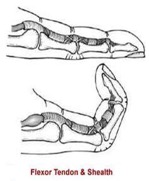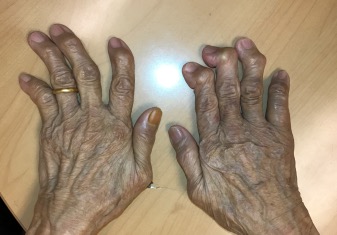Common hand conditions
There are three affecting seniors – trigger finger, carpal tunnel syndrome and hand osteoarthritis.
BY: Dr Renita Sirisena
Degenerative conditions of the hand commonly occur in older patients. The three more commonly seen conditions are trigger finger, carpal tunnel syndrome, and hand osteoarthritis. In this article, we explain these conditions, how one can prevent or decrease the rate of progression of these conditions as well as the treatment options available.
TRIGGER FINGER

Trigger finger is when patients suffer pain or discomfort over the base of the finger as they try to bend or straighten their finger.
Trigger finger is the most common finger aliment affecting the general population with 2.2 percent over the age of 30 presenting with this condition. Patients suffer from pain or discomfort over the base of the finger as they try to bend or straighten their finger. In some cases, patients complain of a locking or clicking of the finger with stiffness of the adjacent joint.
Women over the age of 50 are two to six times more likely to be affected, compared to males. Multiple digit involvement is not uncommon with the middle finger and thumb being the two more commonly affected fingers based on our local data.
The predisposing factors for developing trigger finger are advanced age and chronic repetitive motion like gripping. There is also a higher prevalence of trigger finger in patients with diabetes mellitus, rheumatoid arthritis and kidney disease.
The options of management for such trigger fingers range from non-surgical to surgical. Non-surgical management comprises hand therapy or a steroid injection. Hand therapy focuses on splinting, finger exercises and activity modification. Therapy is usually recommended for patients with early trigger finger and it does take three to four months till the effects of therapy are seen.
A steroid injection comprises of a mixture of local anaesthetic and a steroid. It is a simple procedure which can be performed in a clinic setting and administered in a sterile fashion. For each finger, the total number of injections one can get in a lifetime is usually limited to two, with a minimum interval of six months between injections. Its effects are usually seen between 10 to 20 days after the injection. The risks of a steroid injection include:
- Infection.
- Bleeding.
- Injury to nerve and vessels.
- Skin hypopigmentation (skin whitening).
- 30 to 40 percent chance of recurrence.
- Tendon injury.
- Fat necrosis.
Lastly, surgery is recommended for patients who have not responded well to conservative treatment. The surgery is a day procedure that is performed under local anaesthesia. During the surgery, the thickened tissue overlying the tendon will be released and this will allow the tendon to glide smoothly. It is a predictable operation, however, it does have risks as well. From the local anaesthesia, there is a risk of allergic reaction and with an operation, there are risks of infection, bleeding, two weeks for wound healing, need for post-operative therapy to improve motion of the finger, injury to the nerve and vessels, tendon injury, and incomplete release.
CARPAL TUNNEL SYNDROME
Carpal tunnel syndrome is a common cause of hand numbness which usually affects the thumb, index, middle and half of the ring fingers. Patients commonly find these symptoms worse in the early mornings and tend to be awakened from their sleep due to the numbness. Other commonly used terms to describe their discomfort include burning or tingling sensation in the affected fingers. In more severe cases, patients will have decreased grip strength and may have difficulties doing certain tasks like buttoning their shirts.
Carpal tunnel syndrome is due to an increase in pressure within the carpal tunnel. This increased pressure causes compression and dysfunction of the median nerve. It is associated with pregnancy, diabetes mellitus, hand osteoarthritis and repetitive wrist trauma. Women are three to 10 times more likely to be affected than men, with the peak age to develop symptoms being between 45 to 60 years old.
A nerve conduction study (NCS) and/or electromyography (EMG) are commonly ordered tests that your doctor may choose to perform based on your clinical history and symptoms. A NCS involves the placement of probes along the course of the nerve and is a test of the electrical conductivity of your nerve. An EMG assesses muscle activity with the use of needle electrodes placed through the skin. These tests help to confirm the diagnosis as well as grade the degree of nerve injury from the compression.
Non-operative treatment options for carpal tunnel syndrome consists of night splinting with a brace and nerve gliding exercises. Therapy is usually recommended for patients with intermittent symptoms of a short duration. For patients with more persistent symptoms that are of a longer duration, surgery may be recommended. The main aim of the surgery would be to prevent further worsening of symptoms and deterioration of nerve function. Surgery is performed under local anaesthesia as a day surgical case.
From the local anaesthesia, there is a risk of allergic reaction and with an operation, there are risks of infection, bleeding, two weeks for wound healing, injury to the nerve and vessels, persistent surgical site pain, incomplete release and unpredictable recovery of sensation.
HAND OSTEOARTHRITIS
Hand osteoarthritis is a common degenerative condition of the hand joints where patients present with joint pain, stiffness, swelling and deformity. The prevalence of joint pain ranges from three to 25 percent of the population, with the most commonly affected joints being the distal joint of the finger and the base of the thumb.
Hand osteoarthritis is predominantly seen in women, with the extent and incidence of arthritis increasing with age. Osteoarthritis can be related to previous hand injury, but can also have no obvious predisposing cause.
Tests that are commonly performed include radiographs of the affected digits/hands and a panel of blood tests. These tests are done to rule out other differential diagnoses like rheumatoid arthritis or gout.
The management of hand osteoarthritis begins with conservative therapy and lifestyle modifications. This involves splinting of the affected joint, analgesia and therapy aimed at small joint protection. A steroid injection can be considered in patients who continue to have persistent pain. However, this does not cure the osteoarthritis and the symptomatic relief may vary from patient to patient. Surgical options vary depending on the severity of the arthritis and they range from cleaning, fusing or replacing the affected joint.
Conclusion
Degenerative conditions of the hand are common and their symptoms can range from joint pains and deformities to finger locking and hand numbness, which can cause significant functional debilitation if left untreated. Early accurate diagnosis and appropriate treatment are crucial to avoid the morbidities of these conditions.
Dr Renita Sirisena is an associate consultant in the Department of Hand & Reconstructive Microsurgery at the National University Hospital.
(** PHOTO CREDITS: National University Hospital)



0 Comments